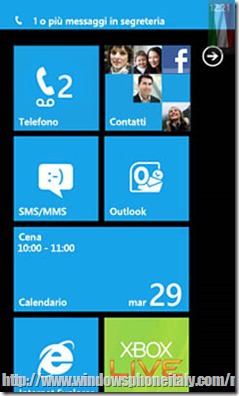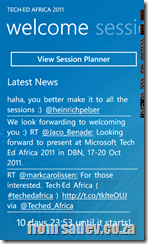Windows Phone 7: Professional Tips - Press and hold
 The keyboard on WP7 is an amazing area which you will be often exposed to, so it is not surprising it contains some hidden gems to make the experience better, like double tap.
The keyboard on WP7 is an amazing area which you will be often exposed to, so it is not surprising it contains some hidden gems to make the experience better, like double tap.
Today the hidden gem is the ability to press and hold keys to get pop ups with other options, which could save you navigating to the symbols/number section or even give you access to options that you never had anywhere else.
If you have a look at the screen shot you will see the dot key has been pressed and held and the popup has dash, exclamation, colon, question mark and dot in it. Much easier to find than going to the symbols section.
Other keys with this. Letters shown in lower case support this on upper case too:
- e – ê è ë é
- t – þ
- y – ý ÿ
- u – ù ú û ü
- i – ì í î ï
- o – ò ó ô ö ø œ
- a – ä á â à å æ
- s – ß §
- d – ð
- c – ç ©
- n – ñ
- m – ɥ
- 1 – ⅓ ¼ ½
- 2 – ² ⅔
- 3 – ¾ ³
- 0 – °
- £ – $ ¢ € ¥ ¤
- ( – < { [
- ) – > } ]
- - - _ ~ ¬ ·
- ! – ¡
- ' – ´ `
- " – « » “ ”
- ? - ¿
Windows Phone 7: Professional Tips & Dismiss notifications
 Windows Phone 7 supports little pop up notifications, which are called toasts (cause they pop up like bread in a toaster). You will see these when you get a text message (SMS) or from games (like Tanks) or in chat programs like WhatsApp.
Windows Phone 7 supports little pop up notifications, which are called toasts (cause they pop up like bread in a toaster). You will see these when you get a text message (SMS) or from games (like Tanks) or in chat programs like WhatsApp.
These can linger around for a little bit, but you can get rid of them quickly – just swipe across them, like you were flicking them away and they will rush off your screen.
I use this a lot with WhatsApp when I get multiple messages quickly so I can clear the first and see the second toast which is under it or when I am playing a game and I want to get that SMS off screen so I can continue to play.
It’s another example of the UX in the phone having great little touches.
The Arturo Grid for Windows Phone 7 in PNG & GIMP
 Arturo Toledo works at Microsoft on the Windows Phone Design Studio team, and last week I had the chance to attend phone training with him. In that training he showed a grid he used for layout so that his apps match the layout of Windows Phone 7 apps – I call this the Arturo Grid.
Arturo Toledo works at Microsoft on the Windows Phone Design Studio team, and last week I had the chance to attend phone training with him. In that training he showed a grid he used for layout so that his apps match the layout of Windows Phone 7 apps – I call this the Arturo Grid.
Yesterday he posted about it and released an Expression Design version of it, which is great if you have Expression Design… but if you don’t it can be a problem. So I recreated it using the free graphics tool, The GIMP, and produced a transparent PNG version so that it can work in just about anything!
Downloads
- Layout.png
- layout.xcf (GIMP version)
How I did it?
GIMP is a fantastic tool and I thought I would share how I created this layout. First I started with a new image, with the resolution of 480 x 800 and a transparent background.
Next run Filters ► Render ► Pattern ► Grid and set the parameters as in the screen shot below. Note the offset horizontal & vertical lines are not linked. What we are doing here are creating grids of 37x37 (25 + 12 based off the Arturo Grid) with line width of 12 (so the space that is left is 25x25). The offset is +6 so that it pushes out, because the line widths are based on the middle of the line and not the edge.
Now add two layers, another transparent one and a white backed layer.
Place the new transparent at the bottom and the white in second place.
and now merge down the grid layer onto the white layer.
Now drag on guides:
- Vertical: 24px
- Vertical: 456px
- Horizontal: 56px
- Horizontal: 784px
and select that region.
Create a new
Then use Select ► Invert and press delete. This removes the area around the grid for the bleed (padding) area that your app shouldn’t use.
Now use the Fuzzy Select Tool (aka the magic wand selector tool) and click on the black.
Now hit delete to remove those black lines leaving just the white squares.
You can tweak the colours using the colour exchange tool (Colors ► Map Color ► Exchange) and you can tweak the transparency using the Opacity option on the layer tool to make it more transparent.
There you go, now you are done ![]()
Windows Phone 7: Professional Tips - Double tap
 When you want to make sure something is dead (finished), you shoot it twice – also known as a double tap. Windows Phone 7 supports this too… for sentences.
When you want to make sure something is dead (finished), you shoot it twice – also known as a double tap. Windows Phone 7 supports this too… for sentences.
When typing, double tap the space key and it will insert a full stop and a space!
Considering the size of the space key and how easy it is to double tap, rather than find the smaller dot key and move to the space key it can save you a little.
This is just one of the many awesome UX features in the phone!
Tech·Ed Africa: Slides, Scripts & Thoughts
 WOW! I am sitting here under s a fake tree in a fake city that is Micropolis (also known as the Tech·Ed Africa 2011 expo, and it is AMAZING!). I have just finished my third and final presentation at Tech·Ed Africa 2011 and I just wanted to say THANK YOU THANK YOU THANK YOU THANK YOU THANK YOU THANK YOU THANK YOU THANK YOU THANK YOU THANK YOU THANK YOU THANK YOU THANK YOU THANK YOU THANK YOU THANK YOU THANK YOU THANK YOU to all the people who attended my talks!
WOW! I am sitting here under s a fake tree in a fake city that is Micropolis (also known as the Tech·Ed Africa 2011 expo, and it is AMAZING!). I have just finished my third and final presentation at Tech·Ed Africa 2011 and I just wanted to say THANK YOU THANK YOU THANK YOU THANK YOU THANK YOU THANK YOU THANK YOU THANK YOU THANK YOU THANK YOU THANK YOU THANK YOU THANK YOU THANK YOU THANK YOU THANK YOU THANK YOU THANK YOU to all the people who attended my talks!
This year not only has an amazing expo, but the audiences have been by far the BEST EVER! A special thanks to those who braved 8am to see my .NET 4 talk – 2min before I started I thought “I need sleep”, 2min after the energy from the audience was flowing and I never looked back at what I felt was a great talk, so thank you! ![]()
 A special work of thanks to Suliman and DPE (it is their fake tree I am sitting under) for arranging this and the opportunity to present! I also want to say thanks to the technical team at the event, without who you would not see or hear me, and they were fantastic this year!
A special work of thanks to Suliman and DPE (it is their fake tree I am sitting under) for arranging this and the opportunity to present! I also want to say thanks to the technical team at the event, without who you would not see or hear me, and they were fantastic this year!
For those who attended my talks, or those who couldn’t below are the slides, scripts and misc files used in the talks!
(for those in an RSS reader or on the home page, click read more)
Power features in .NET 4: Investigating the features of .NET 4 which you don’t know about
File downloads
Extend Visual Studio 2010
File downloads
Building Business Applications with Microsoft Visual Studio LightSwitch
File downloads
Tech·Ed Africa 2011 for Windows Phone 7 - 1.1 released
Update: This application has been retired - it was for TechEd 2011 and used the website a lot, the moment the site changes the app will break. It's goal & use are done, so I am happy to retire it.
![]() I’m very happy to announce the 1.1 version of the Tech·Ed Africa app for Windows Phone 7 is now out with a TON of new features:
I’m very happy to announce the 1.1 version of the Tech·Ed Africa app for Windows Phone 7 is now out with a TON of new features:
First up is dedicated in app pages for speakers. This means no more browsing to the website for speaker info. There is also options to view their Twitter, website etc… and since we not on Mango it supports saving the contact details to the device.
Second is similar, dedicated pages for the sessions too!
Third improvement is on the sessions list page – a lot of cleanup and bug fixing there plus lots of options for the grouping (level, audience etc..). This should help finding session info very easily.
The MVP page got a BIG facelift too, with buttons for contact details for each MVP, and a cleaner more bold experience. Of the whole application I am most happy with the UI on this page. I also added a community tweets page that has tweets searched by hash tags!
The welcome page got a cleanup with more focus on the news tweets and the removal of the refresh option, since it refreshes in a lot of ways manual isn’t really needed. It also allows you to launch the BIG new feature…
Session planner! You can now browse and book sessions on your phone! And your phone will give you reminders to attend the sessions!
There is also a lot of UI tweaks – first the background was swopped to the latest UI from Tech·Ed and made a lot darker, so the contrast to the white stands out more the readability is WAY better. I also spent a lot of time with Rudi Grobler getting some of the smaller UI things right, so a big thanks to him! It even has a new and MUCH nicer icon ![]() So what are you waiting for, go update NOW!
So what are you waiting for, go update NOW!
SharePoint Saturday: Lab Rooms
![]()
 Next weekend (15th Oct) Cape Town is hosting the SharePoint Saturday conference and myself and fellow BBDer Rudi Grobler will be there and will be and we are running a very special event in conjunction with the main event: Lab Rooms!
Next weekend (15th Oct) Cape Town is hosting the SharePoint Saturday conference and myself and fellow BBDer Rudi Grobler will be there and will be and we are running a very special event in conjunction with the main event: Lab Rooms!
There will be two special rooms available and in one Rudi will presenting and training on Windows Phone 7 and in the other I will be presenting and training on the Windows Azure Platform!
The cost for this? FREE! It is being sponsored by BBD & the SharePoint Saturday event ![]()
Space in both rooms is VERY VERY limited, so you need to register NOW!
Windows Phone Registration: http://wp7camp.eventbrite.com/
Windows Azure Registration: http://windowsazurecpt.eventbrite.com/
Tech·Ed Africa 2011 Survival Guide
Last year I posted a Tech·Ed Africa related post titled: How to find the gems in the sessions?, which included a slide deck of a presentation I did at BBD for the staff attending Tech·Ed to help them prepare for the event. It was a VERY popular slide deck and this year I am doing the same thing. Below is the 2011 survival guide for Tech·Ed Africa!
If you find it useful please let me know on @rmaclean ![]()
if you looking for more info on the slides, then please download the slide deck and check the notes. There is also a Easter egg slide with interesting information for those who download the slide deck ![]()
Tech·Ed Africa 2011 for Windows Phone 7
Update: Check out the info on the 1.1 version
Update: This application has been retired - it was for TechEd 2011 and used the website a lot, the moment the site changes the app will break. It's goal & use are done, so I am happy to retire it.
![]() I am passionate about Microsoft Tech·Ed Africa, not because I’m a speaker there (and have been many times in the past) but because it is an awesome event. Now in this mobile world every awesome event needs an equally awesome mobile app. Since Microsoft isn’t releasing one for Tech·Ed, I decided to put my skills to use and build a Windows Phone 7 app for the event
I am passionate about Microsoft Tech·Ed Africa, not because I’m a speaker there (and have been many times in the past) but because it is an awesome event. Now in this mobile world every awesome event needs an equally awesome mobile app. Since Microsoft isn’t releasing one for Tech·Ed, I decided to put my skills to use and build a Windows Phone 7 app for the event ![]()
This app is a little different from my other apps as I didn’t have the data, and it is a constantly moving target so I am doing some very smart (and maybe a little sneaky) things to get the content from the www.teched.co.za website!
Version 1 allows you to browse sessions, speakers, get pro tips, see who the awesome MVP’s are, and get official news!
I am working on version 1.1 which include community tweets, proper speaker & session pages and will update with more info as it is released so keep an eye on those updates!
Tech·Ed Pro Tip: DevIdols
 Tech·Ed Africa 2010 introduced a new feature, DevIdols, which was one of the TOP highlights of Tech·Ed, and I am VERY PROUD to announce that it is back this year again!
Tech·Ed Africa 2010 introduced a new feature, DevIdols, which was one of the TOP highlights of Tech·Ed, and I am VERY PROUD to announce that it is back this year again!
DevIdols is a special competition only open to attendees (no speakers or staff) where you get to present on stage for a few minutes to an audience and panel of judges!
The prize? a chance to be a speaker at Tech·Ed 2012!
Now I know for most people the thought of public speaking is scary but this event is different, you have so little time most of it is just a blur and everyone there is in a very friendly mood (normally audience and speakers get a beer or two) so even if you tank no one takes it too seriously and we all have a good laugh.
If you are not a speaker, and I cannot convince you to speak, then let me convince you to come along and watch. You see a bunch of topics, presented in a variety of ways and I promise you that you will have a GREAT time. Keep an eye out on the DPE Blog for more details.























